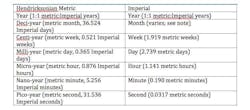In order to get away from strange nonsensical numbers that do not fit together nicely (60 minutes, 24 hours, 7 days, 12 months of varying length, etc., not to mention the a.m./p.m. conundrum and Leap Year), this new and superior system is based on the number 10.
(I am of course aware that other metric calendars have been proposed, and even used briefly, such as the old French Republican calendar. However, all of them contain some artifact or another of the Imperial system and are not truly decimal, whereas HMC is.)
Thus:
One metric year is the same as one Imperial sidereal year and comprises: 10 metric months (deci-years), each of 10 metric weeks (centi-years), each of 10 metric days (milli-years).
(1 year = 10 deci-years = 100 centi-years = 1,000 milli-years)
One metric day (milli-year) comprises: 10 metric hours (micro-years), each of 10 metric minutes (nano-years), each of 10 metric seconds (pico-years).
(1 milli-year = 10 micro-years = 100 nano-years = 1,000 pico-years)
From this, it can be seen that conversion from metric years to seconds (pico-years) or anything in between is fast and easy via simple movement of the decimal point. The system is also far more conducive to the use of scientific notation (powers of 10) than the old Imperial system. Moreover, the making of calendars now becomes a one-time job since all deci-years (metric months) are the same.
Another advantage of the Hendricksonian Metric Calendar is that time's volume and weight can be determined easily using only measures of length. Volume is straightforward, length times width times height (or pi times radius squared times height for cylindrical time); weight requires a simple extension of the system via the addition of the gram-year. One gram-year of time is equal to the water weight (on Earth) of one cubic centi-year.
To provide a basis for comparison, here follows a brief conversion chart that correlates units of HMC time with their counterparts in Imperial time.
- 36.524 Imperial days
- 5.214 Imperial weeks
- 1.177 Imperial Januaries, Marches, Mays, Julys, Augusts, Octobers and Decembers
- 1.217 Imperial Aprils, Junes, Septembers and Novembers
- 1.292 Imperial Februaries (considered as 28.248 Imperial days each to eliminate Leap Year)
Metric months (deci-years) neither have nor need names as do Imperial months; instead they are simply numbered 1-10, and all are of the same length. This is done primarily for simplicity's sake and also to remove non-numerical artifacts left over from the Imperial system. Similarly, metric days (milli-years) also are unnamed and are numbered 1-1,000 to avoid confusing repetitions. Metric weeks (centi-years) are numbered 1-100 rather than the mathematically unhandy 1-52 of Imperial weeks.
As to when to begin the annual calendar, it would be best to start it on one of the solstices or equinoxes (it doesn't really matter which one) so that their dates fall on the nice round milli-year numbers of 0, 250, 500 and 750. To ease the transition from the old Imperial system, the Winter Solstice is probably the most sensible "New Year" starting point.
So assuming a start point of the Winter Solstice, for example, the Imperial date June 9th (Julian date 160 plus the "leftover" 10 days in December) can be expressed metrically in terms of year, month, week and day simply by moving the decimal point as appropriate: 0.466 year, 4.66 deci-year, 46.6 centi-year and 466 milli-year. Note that the metric method also improves precision by an order of magnitude by including the week in the date, which the Imperial system inexplicably omits.
Similarly, time of day (milli-year) becomes more manageable as well. For example, 10:15 a.m. on June 9th becomes 466.1169 milli-year. Simple, no? And if deemed necessary, units of time can be cut even finer, down to femto-years and smaller.
As can be seen by the examples above, HMC offers far greater precision than Imperial time. Moreover, adjustments for irregularities in the Earth's rotation via "leap seconds" only need be applied every 10 years rather than every 3.
As it is unrealistic to expect overnight adoption of any new system, some transition period from the Imperial system to the metric must be expected, as well as some resistance from the unenlightened and those vested in the status quo. Success of the transition will depend upon the widest possible dissemination of and advocacy for the Hendricksonian Metric Calendar system described herein, in particular among young people who are not yet mentally entrenched in obsolescence.
While the new metric calendar is internally simple, conversions to and from Imperial time can be awkward, primarily because of the Imperial system's chaotic nature. Of course, over time (however you measure it), the need for such conversions will decrease as the new system becomes mainstream. In order to facilitate understanding in the meantime, some conversion data are appended to the end of this article. I earnestly hope that said data, combined with the article itself, will prove helpful in this inevitable move to a better system of measurement.
The Hendricksonian Metric Calendar. It's Time®.
Ron Hendrickson is BTR's managing editor. Reach him at [email protected].
Appendix
One metric year (year) equals:
- One Imperial year
- 12 Imperial months (of varying lengths)
- 26.07 Imperial fortnights
- 52.14 Imperial weeks
- 365.24 Imperial days
One metric month (deci-year) equals:
- 36.524 Imperial days
- 5.214 Imperial weeks
- 1.177 Imperial Januaries, Marches, Mays, Julys, Augusts, Octobers and Decembers
- 1.217 Imperial Aprils, Junes, Septembers and Novembers
- 1.292 Imperial Februaries (considered as 28.25 Imperial days each to eliminate Leap Year)
One metric week (centi-year) equals:
- 0.521 Imperial weeks
- 3.652 Imperial days
- 87.6 Imperial hours
One metric day (milli-year) equals:
- 0.365 Imperial days
- 8.76 Imperial hours
One metric hour (micro-year) equals:
- 0.876 Imperial hours
- 52.56 Imperial Minutes
- 3153.6 Imperial seconds
One metric minute (nano-year) equals:
- 5.256 Imperial minutes
- 315.36 Imperial seconds
One metric second (pico-year) equals:
- 0.5256 Imperial minutes
- 31.536 Imperial seconds
Handy conversions of some commonly used Imperial periods of time:
- 24-hour rotation of the Earth's axis: 27.384 micro-years
- 7-day week: 19.173 milli-years
- 28.5-day lunar cycle: 78.062 milli-years
- One Earth orbit of the Sun: 1 year
Editor's note: If you've actually read this far, good on you. The ridiculous assumptions and bad math/logic are intentional. It's a joke. Relax.






